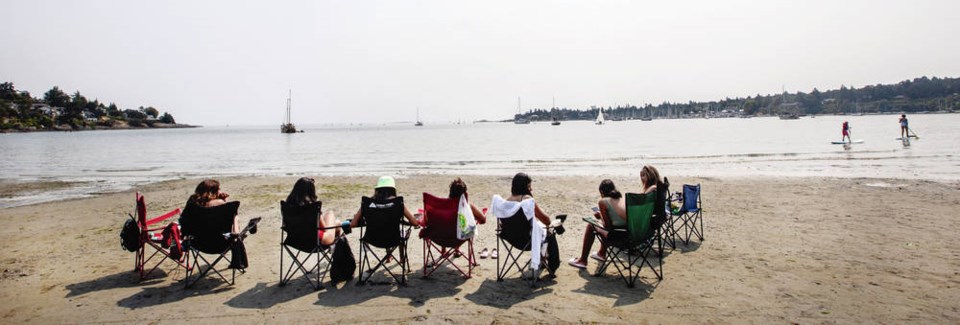It’s hot and it’s dry, but relief is as close as Sunday, Environment Canada says.
So far this month we have only seen 5.1 millimetres of rain, a mere 17 per cent of the average rainfall for this period.
The heat wave started in earnest on Thursday, but its intensity varied around the capital region, with a high of 35.3 at Victoria International Airport and 27.6 at Gonzales. The heat continues today and Saturday, with high 20s and low 30s.
A breakdown of the high-pressure system hovering over B.C. is forecast for Sunday. “We see a pattern change, with a cold front sweeping the province and bringing with it a drop in temperature by a few degrees and a chance of scattered rain showers,” said Bobby Sekhon, a meteorologist with Environment Canada.
The hot and dry spell has put Vancouver Island and the southern Gulf Islands on a Level 4 drought alert.
B.C. uses a six-level (0 to 5) classification to reflect the severity of a drought. A Level 4 drought means adverse impacts on both the environment and water users. The east coast of Vancouver Island entered Level 4 on July 7, followed by the west coast on July 28.
The Sooke Reservoir has shielded Greater Victoria residents from the impact of drought. The region is under a Stage 1 water conservation plan, running from May to September, which still allows limited lawn and garden watering.
The reservoir water level was at 74.9% on Thursday afternoon. While that number is within the five-year average for this time of the year, it is at the low end, the CRD said.
CRD water customers are using an average of 215 million litres a day in August, up from an average of 197 million litres in the preceding four years.
In the Cowichan Valley Regional District, the drought is having a greater impact. The district is made up of 20 water utilities, sourcing a combination of ground and surface water.
A number of customers have been trucking in water since June.
Cowichan Valley reservoirs have dipped low enough to cause concern about having enough water to fight fires.
If the fall rains do not arrive in time the district has large pumps on standby. “In an emergency, we may have to pump water from Cowichan Lake to artificially keep the rivers and streams flowing,” said Brian Dennison, manager, water management for the Cowichan Valley Regional District.
The district only supplies water to residences, leaving farmers and other agricultural users to find their own sources, mainly wells.
Farmer James Lockwood had sprinklers on the roof of his barn and misters running inside to keep his flock of 5,800 hens from overheating.
He said he won’t know until the end of the week if his crops will survive but during the last heat wave, in late June, he lost about 6,000 heads of lettuce and some of his chicken flock.
“We can handle temperature fluctuation of two to three degrees, but not 10,” said Lockwood, who runs Lockwood Farms with his wife Cammy. “We had the fans going but all they did was to suck in hot air.”
He grows up to 150 varieties of vegetables and produces about two million eggs a year, enough to feed 8,000 people annually on average.
Consumers may notice a growing number of medium-sized eggs in the market, he said, because chickens under stress lay smaller eggs.
When tucking into their eggs in the morning Victorians can expect to see hazy skies for the next two days as smoke from the wildfires burning in the Interior drift west.
Air quality advisories were issued across southern British Columbia, including most of Vancouver Island.
Exposure to smoke can affect health and people are advised to reduce their level of physical activity. Respiratory symptoms can include mild irritation, dry cough, sore throat or difficulty breathing.
- - -
To comment on this article, write a letter to the editor: [email protected]



